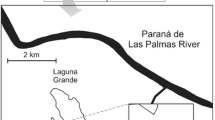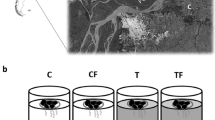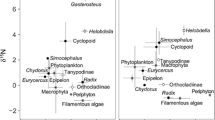Abstract
Effects of fish predation on consumers tend to be particularly strong in oligotrophic Arctic and sub-Arctic lakes. However, it remains unclear whether the fish influence the trophic structure and dynamics of naturally eutrophic lakes in these cold environments with simple food web structures. To study this, we conducted a 3-month in situ-controlled experiment in sub-Arctic Lake Mývatn, Iceland. We used the planktivorous fish three-spined sticklebacks (Gasterosteus aculeatus) as the main top predator. The cladocerans Eurycercus lamellatus and Acroperus harpae were significantly associated with fishless enclosures, whereas the rotifers Polyarthra sp. and Filinia terminalis were significantly associated with the fish enclosures. Fish predation led to a significant increase in phytoplankton biomass and a reduction in the zooplankton:phytoplankton biomass ratio, the mean zooplankton length and cladoceran mean biomass. Fish effects might have been stronger if a bloom of Anabaena in August had not overridden potential cascading effects. We argue that both top-down and bottom-up forces are important for structuring the communities in the lake. Our results suggest that Arctic and sub-Arctic lakes may undergo important changes in trophic dynamics if they get warmer and more nutrient rich as expected with the global climate change.



Similar content being viewed by others
References
Adalsteinsson, H., 1979. Size and food of Arctic char Salvelinus alpinus and stickleback Gasterosteus aculeatus in Lake Mývatn. Oikos JSTOR 32: 228–231.
Allen, M. B. & D. I. Arnon, 1955. Studies on nitrogen-fixing blue-green algae. I. Growth and nitrogen fixation by Anabaena cylindrica Lemm. Plant Physiology 30: 366.
Anderson, R. S., 1971. Crustacean plankton of 146 alpine and subalpine lakes and ponds in western Canada. Journal of the Fisheries Board of Canada 28: 311–321.
Anderson, R. S., 1972. Zooplankton composition and change in an alpine lake. Verhandlungen der Internationale Vereinigung der Limnologie 18: 264–268.
Andersen, T., P. S. Cranston, & J. H. Epler (eds), 2013. Chironomidae of the Holarctic Region: keys and Diagnoses. In Part 1 - Larvae. Insect Systematics and Evolution Supplements. Entomological Society of Lund, Sweden, pp 573
Bartrons, M., Á. Einarsson, R. L. G. Nobre, C. M. Herren, K. C. Webert, S. Brucet, S. R. Ólafsdóttir & A. R. Ives, 2015. Spatial patterns reveal strong abiotic and biotic drivers of zooplankton community composition in Lake Mývatn, Iceland. Ecosphere 6: 1–20.
Bates, D., M. Mächler, B. Bolker, & S. Walker, 2014. Fitting linear mixed-effects models using lme4. arXiv preprint. arXiv:1406.5823.
Benjamini, Y. & Y. Hochberg, 2000. On the adaptive control of the false discovery rate in multiple testing with independent statistics. Journal of Educational and Behavioral Statistics 25: 60–83.
Benjamini, Y. & D. Yekutieli, 2001. The control of the false discovery rate in multiple testing under dependency. Annals of Statistics 29: 1165–1188.
Bottrell, H. H., 1976. A review of some problems in zooplankton production studies. Norwegian Journal of Zoology 24: 419–456.
Brett, M. T. & C. R. Goldman, 1996. A meta-analysis of the freshwater trophic cascade. Proceedings of the National Academy of Sciences 93: 7723–7726.
Brooks, J. L. & S. I. Dodson, 1965. Predation, body size, and composition of plankton. Science 150: 28–35.
Brucet, S., D. Boix, L. W. Nathansen, X. D. Quintana, E. Jensen, D. Balayla, M. Meerhoff & E. Jeppesen, 2012. Effects of temperature, salinity and fish in structuring the macroinvertebrate community in shallow lakes: implications for effects of climate change. PLoS ONE 7: e30877.
Cheung, W. W. L., J. L. Sarmiento, J. Dunne, T. L. Frölicher, V. W. Y. Lam, M. L. D. Palomares, R. Watson & D. Pauly, 2013. Shrinking of fishes exacerbates impacts of global ocean changes on marine ecosystems. Nature Climate Change 3: 254–258.
Christoffersen, K. S., S. L. Amsinck, F. Landkildehus, T. L. Lauridsen & E. Jeppesen, 2008. Lake flora and fauna in relation to ice-melt, water temperature and chemistry at Zackenberg. Advances in Ecological Research 40: 371–389.
De Cáceres, M., P. Legendre & M. Moretti, 2010. Improving indicator species analysis by combining groups of sites. Oikos 119: 1674–1684.
de Winter, J. C. F., 2013. Using the Student’s t-test with extremely small sample sizes. Practical Assessment, Research & Evaluation 18: 1–12.
DeMott, W. R., 1989. The role of competition in zooplankton succession. In Sommer, U. (ed.), Plankton Ecology. Springer, Berlin: 195–252.
Dufrêne, M. & P. Legendre, 1997. Species assemblages and indicator species: the need for a flexible asymmetrical approach. Ecological Monographs 67: 345–366.
Dumont, H. J., I. Van de Velde & S. Dumont, 1975. The dry weight estimate of biomass in a selection of Cladocera, Copepoda and Rotifera from the plankton, periphyton and benthos of continental waters. Oecologia 19: 75–97.
Einarsson, A., 2010. Fæðuvefur Mývatns. Náttúrufræðingurinn 79: 57–67.
Einarsson, Á., G. Stefánsdóttir, H. Jóhannesson, J. S. Ólafsson, G. M. Gíslason, I. Wakana, G. Gudbergsson & A. Gardarsson, 2004. The ecology of Lake Myvatn and the River Laxá: variation in space and time. Aquatic Ecology 38: 317–348.
Emmrich, M., S. Pédron, S. Brucet, I. J. Winfield, E. Jeppesen, P. Volta, C. Argillier, T. L. Lauridsen, K. Holmgren, T. Hesthagen & T. Mehner, 2014. Geographical patterns in the body-size structure of European lake fish assemblages along abiotic and biotic gradients. Journal of Biogeography 41: 2221–2233.
Ger, K. A., P. Urrutia-Cordero, P. C. Frost & L.-A. Hansson, 2016. The interaction between cyanobacteria and zooplankton in a more eutrophic world. Harmful Algae 54: 128–144.
Gislason, G. M., A. Gudmundsson & A. Einarsson, 1998. Population densities of the three-spined stickleback (Gasterosteus aculeatus L.) in a shallow lake. Verhandlungen der Internationale Vereinigung der Limnologie 26: 2244–2250.
Gliwicz, Z. M., O. Kinne, & W. Lampert, 2003. Between Hazards of Starvation and Risk of Predation: the Ecology of offshore Animals. International Ecology Institute Oldendorf/Luhe.
González-Bergonzoni, I., F. Landkildehus, M. Meerhoff, T. L. Lauridsen, K. Özkan, T. A. Davidson, N. Mazzeo & E. Jeppesen, 2014. Fish determine macroinvertebrate food webs and assemblage structure in Greenland subarctic streams. Freshwater Biology 59: 1830–1842.
Hobbie, J. E. 1984. Polar limnology. In Taub, F. B. (ed) Lakes and Rivers. Ecosystems of the World. vol. 23, pp 63–104. Amsterdam: Elsevier.
Hobbie, J. E., B. J. Peterson, N. Bettez, L. Deegan, W. J. O’Brien, G. W. Kling, G. W. Kipphut, W. B. Bowden & A. E. Hershey, 1999. Impact of global change on the biogeochemistry and ecology of an Arctic freshwater system. Polar Research 18: 207–214.
Hobson, K. A. & H. E. Welch, 1995. Cannibalism and trophic structure in a high Arctic lake: insights from stable-isotope analysis. Canadian Journal of Fisheries and Aquatic Sciences 52: 1195–1201.
Ives, A. R., Á. Einarsson, V. A. A. Jansen & A. Gardarsson, 2008. High-amplitude fluctuations and alternative dynamical states of midges in Lake Myvatn. Nature 452: 84–87.
Jeppesen, E., T. Lauridsen, S. F. Mitchell & C. W. Burns, 1997. Do planktivorous fish structure the zooplankton communities in New Zealand lakes? New Zealand Journal of Marine and Freshwater Research 31: 163–173.
Jeppesen, E., K. Christoffersen, F. Landkildehus, T. Lauridsen, S. L. Amsinck, F. Riget & M. Søndergaard, 2001. Fish and crustaceans in northeast Greenland lakes with special emphasis on interactions between Arctic charr (Salvelinus alpinus), Lepidurus arcticus and benthic chydorids. Hydrobiologia 442: 329–337.
Jeppesen, E., J. P. Jensen, C. Jensen, B. Faafeng, D. O. Hessen, M. Søndergaard, T. Lauridsen, P. Brettum & K. Christoffersen, 2003. The impact of nutrient state and lake depth on top-down control in the pelagic zone of lakes: a study of 466 lakes from the temperate zone to the arctic. Ecosystems 6: 313–325.
Jeppesen, E., T. Mehner, I. J. Winfield, K. Kangur, J. Sarvala, D. Gerdeaux, M. Rask, H. J. Malmquist, K. Holmgren & P. Volta, 2012. Impacts of climate warming on the long-term dynamics of key fish species in 24 European lakes. Hydrobiologia 694: 1–39.
Jónasson, P. M., 1979. Ecology of eutrophic, subarctic Lake Myvatn and the River Laxa (Iceland): introduction. Oikos 32: 1–308.
Jónasson, P. M., & H. Adalsteinsson, 1979. Phytoplankton Production in Shallow Eutrophic Lake Mývatn, Iceland. Oikos 32(1/2): 113–138.
Jónsson, E., A. Gardarsson & G. Gíslason, 1986. A new window trap used in the assessment of the flight periods of Chironomidae and Simuliidae (Diptera). Freshwater Biology 16: 711–719.
Knapp, R. A., K. R. Matthews & O. Sarnelle, 2001. Resistance and resilience of alpine lake fauna to fish introductions. Ecological monographs Eco Soc America 71: 401–421.
Leibold, M. A., 1989. Resource edibility and the effects of predators and productivity on the outcome of trophic interactions. American Naturalist 134: 922–949.
Lin, S.-J., L.-J. He, P.-S. Huang & B.-P. Han, 2005. Comparison and improvement on the extraction method for chlorophyll a in phytoplankton [J]. Ecologic Science 1: 2.
Malley, D. F., 1989. Range of Variation in Estimates of Dry Weight for Planktonic Crustacea and Rotifera From Temperate North American Lakes: Canadian technical report of fisheries and aquatic sciences, no. 1666. Winnipeg : Fisheries and Oceans, Canada, p 49.
McCauley, E., 1984. The estimation of the abundance and biomass of zooplankton in samples. In Downing, J. A. & F. H. Rigler (eds.), A manual on methods for the assessment of secondary productivity in fresh waters. Blackwell, Oxford: 228–265.
McQueen, D. J., J. R. Post & E. L. Mills, 1986. Trophic relationships in freshwater pelagic ecosystems. Canadian Journal of Fisheries and Aquatic Sciences 43: 1571–1581.
Michelutti, N., A. P. Wolfe, R. D. Vinebrooke, B. Rivard & J. P. Briner, 2005. Recent primary production increases in arctic lakes. Geophysical Research Letters 32(19): L19715.
Millet, A., B. K. Kristjánsson, Á. Einarsson & K. Räsänen, 2013. Spatial phenotypic and genetic structure of threespine stickleback (Gasterosteus aculeatus) in a heterogeneous natural system, Lake Mývatn, Iceland. Ecology and Evolution 3: 3219–3232.
Müller-Navarra, D. C., M. T. Brett, A. M. Liston & C. R. Goldman, 2000. A highly unsaturated fatty acid predicts carbon transfer between primary producers and consumers. Nature 403: 74–77.
Murphy, J. & J. Riley, 1962. A modified single solution method for the determination of phosphate in natural waters. Analytica Chimica Acta 27: 31–36.
Narum, S. R., 2006. Beyond Bonferroni: less conservative analyses for conservation genetics. Conservation Genetics 7: 783–787.
O’Brien, W. J., 1975. Some aspects of the limnology of the ponds and lakes of the Noatak drainage basin, Alaska. Verhandlungen der Internationale Vereinigund der Limnologie 19: 472–479.
Ólafsson, J., 1979. Physical characteristics of lake Mývatn and river Laxá. Oikos 32: 38–66.
R Core Team. 2015. R: A language and environment for statistical computing. - R Foundation for Statistical Computing.
Rigler, F. H., 1975. The Char Lake project, an introduction to limnology in the Canadian Arctic. In: Cameron, T. W. M., & L. W. Billingsley (eds), Energy flow–it’s biological dimensions, A summary of the IBP in Canada 1964–1974. Royal Society of Canada, Ottawa, pp 171–198
Rist, S., 1979. Ecology of Eutrophic Subarctic, Lake Mývatn and the River Laxá. Oikos 32(1/2):67–81
Ruttner-Kolisko, A., 1977. Suggestions for biomass calculation of plankton rotifers. Archiv für Hydrobiologie 8: 1–76.
Sarnelle, O., 1992. Nutrient enrichment and grazer effects on phytoplankton in lakes. Ecology 73(2): 551–560.
Solorzano, L. & J. H. Sharp, 1980. Determination of total dissolved nitrogen in natural waters. Limnology and Oceanography 25: 751–754.
Sommer, U., Z. M. Gliwicz, W. Lampert & A. Duncan, 1986. The PEG-model of seasonal succession of planktonic events in fresh waters. Archiv für Hydrobiologie 106(4): 433–471.
Stross, R. G., M. C. Miller & R. J. Daley, 1980. Zooplankton: Communities, Life Cycles and Production. In Hobbie, J. E. (ed.), Limnology of tundra ponds, Barrow, Alaska. Dowden Hutchinson & Ross, Strousburg: 251–296.
Sun, J. & D. Liu, 2003. Geometric models for calculating cell biovolume and surface area for phytoplankton. Journal of Plankton Research 25: 1331–1346.
Tachet, H., P. Richoux, M. Bournaud & P. Usseglio-Polatera. Invertébrés d'eau douce: systématique, biologie, écologie. vol. 15. Paris: CNRS éditions, 2000. 588 pp.
Throndsen, J., 1995. Estimating cell numbers. Manual on harmful marine microalgae. IOC Manuals and Guides UNESCO Paris 33: 63–80.
Webster, K. E. & R. H. Peters, 1978. Some size-dependent inhibitions of larger cladoceran filterers in filamentous suspensions. Limnology and Oceanography 23: 1238–1245.
Winter, B., 2013. Linear models and linear mixed effects models in R with linguistic applications. arXiv preprint. arXiv:1308.5499.
Acknowledgements
We would like to thank Arnie Einarsson for his constant advice and assistance during fieldwork and for providing useful comments on this manuscript. We also want to thank the Mývatn Research Station (Iceland) for providing us with workspace and facilities to conduct this study. We would like to thank Elisabeth Badosa, Sergi Carrasco, Mariona Munné, Gisela Solà and Beatriz Tintoré for their hard work in the field and the laboratory. This project was supported by the Carlsberg Foundation (Project 2013_01_0535) and the MARS project (Managing Aquatic ecosystems and water Resources under multiple Stress) funded under the 7th EU Framework Programme, Theme 6 (Environment including Climate Change), Contract No.: 603378 (http://www.mars-project.eu). MC was supported by the People Program (Marie Curie Actions) of the Seventh Framework Program of the European Union (FP7/2007–2013) under grant agreement no. 600388 of REA (TECNIOspring Program) and the Agency for Competitiveness and Business of the Government of Catalonia, ACCIÓ. SB was supported by the Marie Curie Intra European Fellowship no. 330249 (CLIMBING) and by the project DFG, Me 1686/7-1. XQ’s contribution was supported by grants from the Spanish “Ministerio de Ciencia e Innovación” (CGL2011-23907) and the Generalitat de Catalunya (Ref. 2014 SGR 484).We thank Anne Mette Poulsen for valuable editorial comments.
Author information
Authors and Affiliations
Corresponding authors
Additional information
Handling editor: Karl E. Havens
Electronic supplementary material
Below is the link to the electronic supplementary material.
Rights and permissions
About this article
Cite this article
Cañedo-Argüelles, M., Sgarzi, S., Arranz, I. et al. Role of predation in biological communities in naturally eutrophic sub-Arctic Lake Mývatn, Iceland. Hydrobiologia 790, 213–223 (2017). https://doi.org/10.1007/s10750-016-3031-0
Received:
Revised:
Accepted:
Published:
Issue Date:
DOI: https://doi.org/10.1007/s10750-016-3031-0




